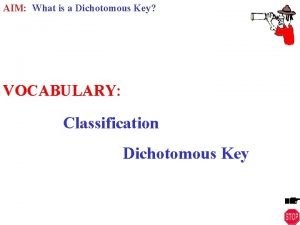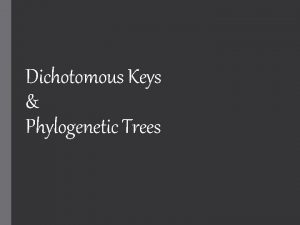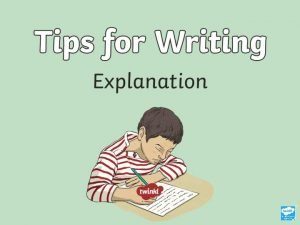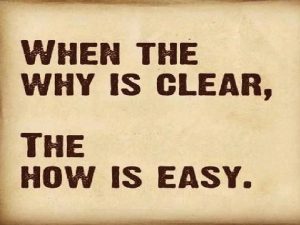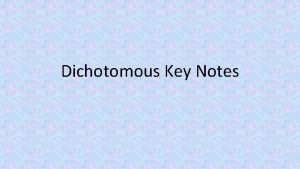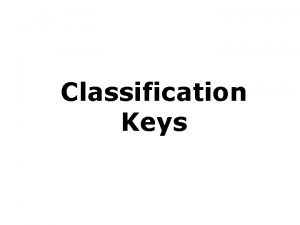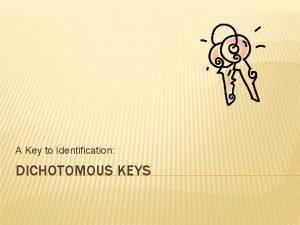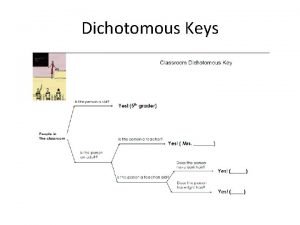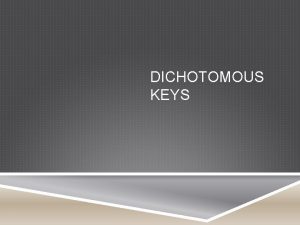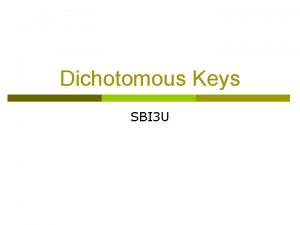DICHOTOMOUS KEYS How do we know what something













- Slides: 13

DICHOTOMOUS KEYS

How do we know what something is? ■ Living things are organized in a system called taxonomy. ■ We use defining traits or characteristics to determine how to split up the organisms. – Diet – Movement – Habitat – Physical characteristics such as color, shape, or size – The ability to reproduce with one another

§ Organisms are grouped together or classified based on common traits. As you move through the levels of taxonomy the characteristics get more specific and the groups generally get smaller. �Kingdom �Phylum �Class �Order �Family �Genus �Species

Dichotomous Keys ■ A dichotomous key is a tool that allows the user to determine the identity of items in the natural world based on the items characteristics ■ "Dichotomous" means “divided into two parts” Greek origin ■ Dichotomous keys always give two distinct choices in each step, often they are opposites – Black/white; good/evil; pointed/rounded

HOW TO USE A DICHOTOMOUS KEY Here are creatures we don’t know! Lets choose one

Choose only 1 creature at a time.

Read the first set of choices (Steps 1 a and 1 b). Decide which statement is true. 1 b is true

Then follow the directions after that step. G O T O P E ST

At step 5 you make another dichotomous choice. GO 5 a is true TO STE P 6!

Continue working through the steps and choices until you come to one that gives you the creatures name. 6 a. The creature has one antennae Go to Step 7. C

Lets try some insects! 1. a. wings covered by an exoskeleton – go to step 2 b. wings freely observed – Go to step 3 2. a. body has a round shape ………. ladybug, a red beetle with black spots b. body has an elongated shape ………. grasshopper, a green insect that hops 1 2 Dragonfly Grasshoppe r 3 4 Housefly Ladybug 3. a. wings point out from the side of the body ………. dragonfly, an insect that is 10 - 15 cm long and lives in marshes b. wings point to the posterior of the body ………. housefly, a flying insect with red eyes and an annoying buzz

WHAT IF I NEED TO § Use constant characteristics rather than variable MAKE A KEY? ones. (Flowers change with the seasons) § Use measurements rather than terms like "large" and "small". § Make the choice a positive one § Something "is" instead of "is not". § If possible, start both choices of a pair with the same word or item. § the body is “round” vs the body is “square” § Finish the dichotomous key with a full description of the organism.

Dichotomou s keys can also be expressed as a flow chart.
 Whale dichotomous key
Whale dichotomous key How to use a dichotomous key
How to use a dichotomous key Define dichotomous key
Define dichotomous key Biodiversity examples
Biodiversity examples Ladybug dichotomous key
Ladybug dichotomous key Dichotomous keys split choices into parts.
Dichotomous keys split choices into parts. Dichotomous key insects answer key
Dichotomous key insects answer key Priesthood keys the restoration of priesthood keys
Priesthood keys the restoration of priesthood keys Keys to literacy keys to content writing
Keys to literacy keys to content writing Tells how something works or why something happens
Tells how something works or why something happens Something old something new poem
Something old something new poem When something represents something else
When something represents something else Smart is something you become not something you are
Smart is something you become not something you are Is adjective a language feature
Is adjective a language feature


